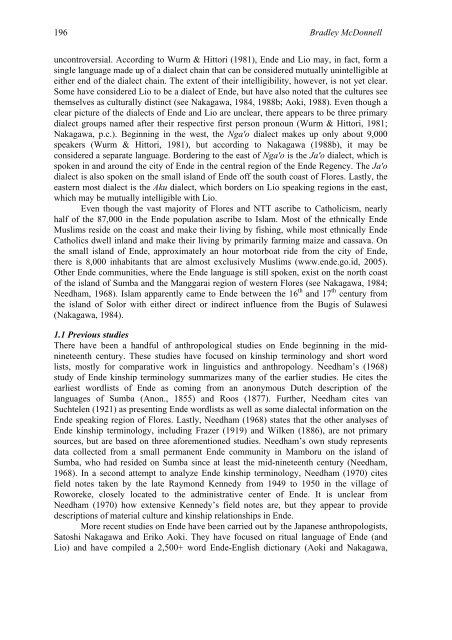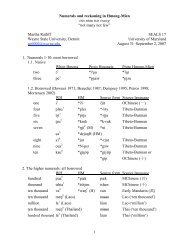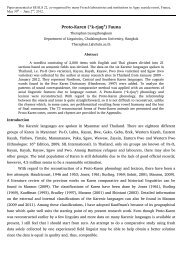proto-southwestern-tai revised: a new reconstruction - seals 22
proto-southwestern-tai revised: a new reconstruction - seals 22
proto-southwestern-tai revised: a new reconstruction - seals 22
Create successful ePaper yourself
Turn your PDF publications into a flip-book with our unique Google optimized e-Paper software.
196 Bradley McDonnell<br />
uncontroversial. According to Wurm & Hittori (1981), Ende and Lio may, in fact, form a<br />
single language made up of a dialect chain that can be considered mutually unintelligible at<br />
either end of the dialect chain. The extent of their intelligibility, however, is not yet clear.<br />
Some have considered Lio to be a dialect of Ende, but have also noted that the cultures see<br />
themselves as culturally distinct (see Nakagawa, 1984, 1988b; Aoki, 1988). Even though a<br />
clear picture of the dialects of Ende and Lio are unclear, there appears to be three primary<br />
dialect groups named after their respective first person pronoun (Wurm & Hittori, 1981;<br />
Nakagawa, p.c.). Beginning in the west, the Nga'o dialect makes up only about 9,000<br />
speakers (Wurm & Hittori, 1981), but according to Nakagawa (1988b), it may be<br />
considered a separate language. Bordering to the east of Nga'o is the Ja'o dialect, which is<br />
spoken in and around the city of Ende in the central region of the Ende Regency. The Ja'o<br />
dialect is also spoken on the small island of Ende off the south coast of Flores. Lastly, the<br />
eastern most dialect is the Aku dialect, which borders on Lio speaking regions in the east,<br />
which may be mutually intelligible with Lio.<br />
Even though the vast majority of Flores and NTT ascribe to Catholicism, nearly<br />
half of the 87,000 in the Ende population ascribe to Islam. Most of the ethnically Ende<br />
Muslims reside on the coast and make their living by fishing, while most ethnically Ende<br />
Catholics dwell inland and make their living by primarily farming maize and cassava. On<br />
the small island of Ende, approximately an hour motorboat ride from the city of Ende,<br />
there is 8,000 inhabitants that are almost exclusively Muslims (www.ende.go.id, 2005).<br />
Other Ende communities, where the Ende language is still spoken, exist on the north coast<br />
of the island of Sumba and the Manggarai region of western Flores (see Nakagawa, 1984;<br />
Needham, 1968). Islam apparently came to Ende between the 16 th and 17 th century from<br />
the island of Solor with either direct or indirect influence from the Bugis of Sulawesi<br />
(Nakagawa, 1984).<br />
1.1 Previous studies<br />
There have been a handful of anthropological studies on Ende beginning in the midnineteenth<br />
century. These studies have focused on kinship terminology and short word<br />
lists, mostly for comparative work in linguistics and anthropology. Needham’s (1968)<br />
study of Ende kinship terminology summarizes many of the earlier studies. He cites the<br />
earliest wordlists of Ende as coming from an anonymous Dutch description of the<br />
languages of Sumba (Anon., 1855) and Roos (1877). Further, Needham cites van<br />
Suchtelen (1921) as presenting Ende wordlists as well as some dialectal information on the<br />
Ende speaking region of Flores. Lastly, Needham (1968) states that the other analyses of<br />
Ende kinship terminology, including Frazer (1919) and Wilken (1886), are not primary<br />
sources, but are based on three aforementioned studies. Needham’s own study represents<br />
data collected from a small permanent Ende community in Mamboru on the island of<br />
Sumba, who had resided on Sumba since at least the mid-nineteenth century (Needham,<br />
1968). In a second attempt to analyze Ende kinship terminology, Needham (1970) cites<br />
field notes taken by the late Raymond Kennedy from 1949 to 1950 in the village of<br />
Roworeke, closely located to the administrative center of Ende. It is unclear from<br />
Needham (1970) how extensive Kennedy’s field notes are, but they appear to provide<br />
descriptions of material culture and kinship relationships in Ende.<br />
More recent studies on Ende have been carried out by the Japanese anthropologists,<br />
Satoshi Nakagawa and Eriko Aoki. They have focused on ritual language of Ende (and<br />
Lio) and have compiled a 2,500+ word Ende-English dictionary (Aoki and Nakagawa,





